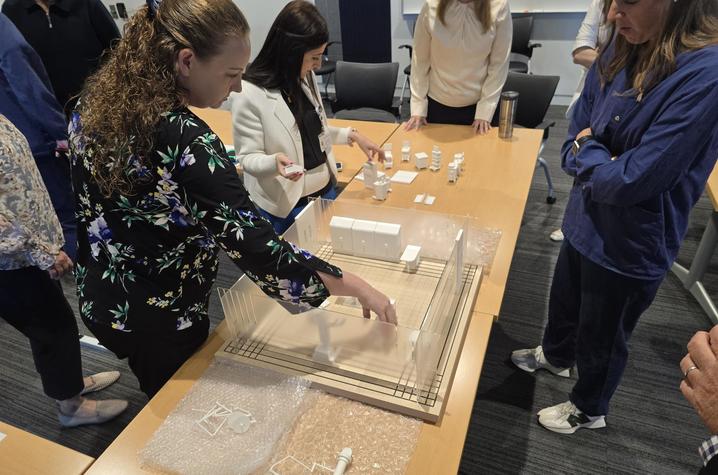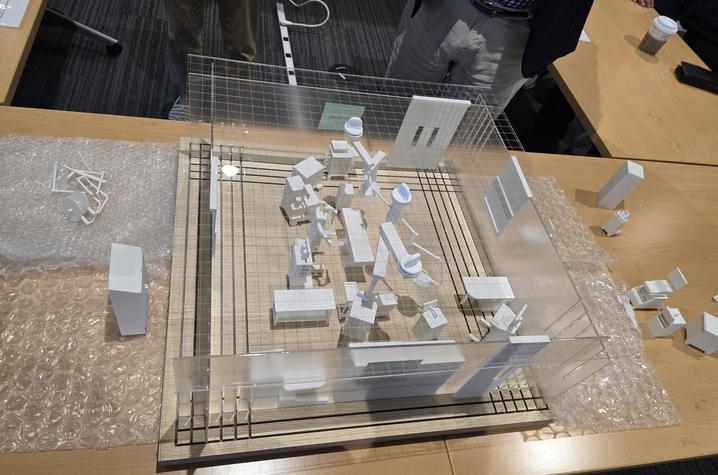Innovative 3D design session helps shape Chandler Hospital expansion
LEXINGTON, Ky. (Sept. 17, 2025) — The University of Kentucky Albert B. Chandler Hospital expansion project is moving forward with innovation and collaboration at the heart of its design process. In a recent design session hosted by the architect’s design team, UK HealthCare, Capital Project Management in Facilities Management and stakeholders gathered to refine the layout of new operating rooms (ORs) using an innovative approach: 3D-printed, to-scale models of hospital equipment and furniture.
Now in the design development phase, the hospital expansion project is focused on refining the schematic layouts and finalizing space requirements for the new ORs. This phase is critical to ensuring that workflows and equipment placement are fully aligned.
Rather than using a higher cost full-scale mock-up, 3D printing technology was utilized to produce scale models of surgical equipment, operating tables and medical furnishings. These tangible pieces allowed surgeons, anesthesiologists, OR techs and other vested stakeholders to physically interact with the layout and test real-world scenarios in a simulated environment.
“It's easier to have tangible pieces to work out workflows, traffic in the room, power and data,” said Angela Walton, capital construction manager senior in Facilities Management. “This collaborative team approach gives you much better input from all users, and it ensures the space will function efficiently for everyone who uses it.”
Participants were able to move the scaled pieces within the layout to explore different room configurations. This hands-on, collaborative method not only gave clinical users a clearer understanding of how the space will function but also provided vital feedback to architects and engineers on how to place key components.
With input directly from those who will use the rooms every day, the project team is ensuring the final OR layout supports safe, streamlined workflows and patient care excellence.
“Physical models work better for some people than 2D drawings and are more intuitive. This exercise allowed the clinical staff to provide extremely valuable insight to the design team to ensure a highly functional operating room layout,” said Masumeh Geranpayeh, facilities planning executive director for UK HealthCare.
Geranpayeh explained that the use of 3D printed models in planning meetings was the first step in helping users visualize the OR in three dimensions — allowing them to understand the sterile field, delineated zones for anesthesia, the surgical team and the flow paths for circulating nurses and support staff. This initial model created a hands-on opportunity for users to interact with the layout, reposition elements and explore different configurations to evaluate what would work best.
“It served as a springboard for discussions around workflow, access and visibility,” she said. “The insights gained from this step will now inform the next phase: a full-scale mockup where we will further assess the room setup to validate line of sight, equipment reach and overall functionality for all stakeholders involved.”
The new patient care tower at UK Chandler Hospital will include adult and pediatric inpatient rooms, observation spaces, operating rooms, minor procedures rooms, diagnostic services, imaging services, pharmacy services, laboratory services and administration and support areas as well as meeting spaces. The design phase of the project was authorized by the 2022 Kentucky General Assembly, endorsed by the UK Board of Trustees HealthCare Committee, and approved by the UK Board of Trustees to begin design work in 2023.
As the state’s flagship, land-grant institution, the University of Kentucky exists to advance the Commonwealth. We do that by preparing the next generation of leaders — placing students at the heart of everything we do — and transforming the lives of Kentuckians through education, research and creative work, service and health care. We pride ourselves on being a catalyst for breakthroughs and a force for healing, a place where ingenuity unfolds. It's all made possible by our people — visionaries, disruptors and pioneers — who make up 200 academic programs, a $476.5 million research and development enterprise and a world-class medical center, all on one campus.






